Reviewed by Grant McCreary on January 2nd, 2011.
It’s obvious that birds are in trouble. But this isn’t just a problem in far-off countries; there are many birds in jeopardy here in the United States. But amazingly, there’s never been a single, comprehensive resource on the subject. That is, until The American Bird Conservancy Guide to Bird Conservation. This guide, which focuses primarily on the U.S., presents accounts for the most threatened birds, habitats, and the threats both face. But, most importantly, it also tells what can be done to help.
Species Accounts
The guide’s first chapter consists of a short species account for each of the 212 birds on the WatchList. The WatchList, a joint project between the American Bird Conservancy (ABC) and the National Audubon Society, includes all of the birds that are officially listed under the Endangered Species Act (ESA), but also those that, without conservation action, may be destined to be listed in the future. Thus, these are the priority species for conservation in the U.S.
Each of the half-page accounts contains a header, text, illustration, and range map. The header, or “fact bar”, includes:
- Species name
- Global population estimate
- Percentage of population found in the U.S.
- Population trend – i.e. increasing, stable, decreasing
- Status – classification within the WatchList and, when listed, ESA
- WatchList combined score – number indicating severity of threat
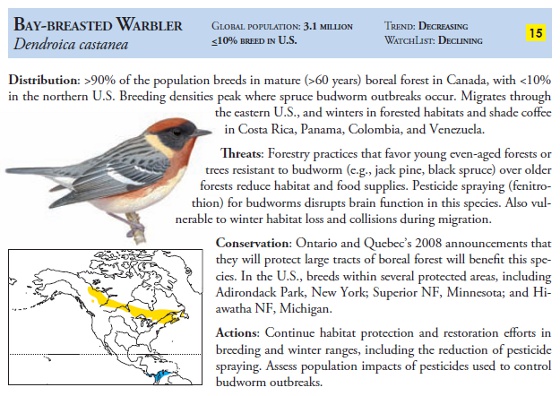
I’ve found the middle column – the population estimate and, especially, the percentage found in the U.S. – particularly enlightening. Even a brief look through the accounts leads to many interesting questions and observations. I know, for instance, that the Red Knot occurs throughout the world, but I was surprised to find that only 10% breed in or migrate through the U.S. Likewise, based on range maps, I would have thought that more than 35% of Varied Thrushes breed here.
The account text consists of:
- Distribution – habitat and range
- Threats
- Conservation – highlights the protected areas where it occurs, and any projects underway
- Actions – important actions that would benefit the species
Each account includes an illustration that, with a few exceptions, depicts a breeding-plumaged male (where there’s a choice). Most of these have been provided by the Handbook of the Birds of the World (HBW). For the most part, they are very attractive. However, when flipping through you may notice that the sparrows stand out. And not in a good way. That’s because they were taken from the National Geographic field guide instead; presumably because sparrows will be included in the last volume of HBW to be published next year and those illustrations weren’t ready yet. I’ve never been a fan of the sparrows in the National Geographic guide, and they really don’t fit in here, all the more since some of them include multiple birds and the accompanying annotations (gender symbols, etc).
The range maps, which show breeding, nonbreeding, and permanent ranges, are also from HBW. Unfortunately, they’re probably my least favorite thing about those otherwise fantastic books. They show the bird’s entire, worldwide range, which is important in a book such as this. But political boundaries are not shown, a big pet peeve of mine, which makes the maps harder to use. The scale can also be a little off, showing much more of the globe than needed. The Red-cockaded Woodpecker map, for instance, shows almost the entirety of the North American continent, with small patches of color clustered in the southeastern U.S. That’s not very helpful.
Habitats
Chapter two presents 12 habitat types, or “birdscapes”. Each of these is introduced by a large, impressive painting depicting its characteristic landscape, birds, other wildlife, vegetation, and threats. The accounts include a map and text that describe the area’s birds, threats, conservation, and actions needed.
For each habitat, 2-10 profiles of representative Important Bird Areas are presented (50 in all). These site accounts give the same sort of information as found in those for the birdscapes.
Threats
This chapter details general and specific issues affecting birds, including habitat loss, invasive species, collisions, pollution, and climate change. Like the other accounts in this guide, these explain the problems, solutions, and actions that need to be taken. Entire books could be written about these issues, so don’t expect more than summaries here. However, they are still excellent overviews of issues as obscure and “minor” as vulture control to major ones like development and window collisions.
International Bird Conservation
Though this guide concentrates on the United States, a chapter has been devoted to international conservation. Well, “international” may be a bit of a stretch – it is still limited to the Americas. But that’s the area in which ABC works, and anything more would have been too broad an area to cover effectively. This chapter’s inclusion makes perfect sense; after all, most of “our” birds also spend time outside the U.S. and threats there are just as relevant.
This chapter is like a miniature version of the rest of the book and follows the same pattern of describing birds, habitats, threats, and actions. It doesn’t include any individual species accounts, but does have seven additional birdscapes with a single IBA highlighted for each.
Strategies and Actions
Before the reader gets to this point they’ve encountered over 200 birds that are in trouble, habitats in danger, and a litany of threats facing birds today. But this final, and most important, chapter brings hope, saving the book from a feeling of doom and gloom. Each preceding chapter includes actions that need to be taken. This one tells how they can be implemented.
In addition to relating many concrete, practical actions that can be taken, the authors present a way forward for bird conservation. This framework lays out a scheme for conservation prioritization that will allow bird conservation to be carried out in a strategic way. A summary of conservation priorities for each state is also included, along with other useful information.
There is also a forward by acclaimed novelist Jonathan Franzen and an introduction that sets the table by presenting a brief history of conservation in the Americas.
When one thinks of books about conservation, illustrations aren’t the first thing that comes to mind. This would still be an incredibly important and useful book without a single one. But I’m happy to say that’s not the case. In addition to the aforementioned species illustrations and birdscape paintings, these pages are adorned with many excellent photographs. All of these illustrations, combined with a nice layout, make this an extremely attractive book.
Writing this book must have been a challenge. The authors had to keep it informative and applicable for professionals working in the field of conservation. On the other hand, it needed to be accessible and relevant to the rest of us, the laymen interested in birds’ welfare. On the whole, I think they struck a good balance. The writing, though a bit dry, is still understandable and should be interesting enough to hold anyone’s attention through the book’s bite-sized sections.
There are no citations or references of any kind in the various accounts. This makes it easier to read, but much less useful. It’s hard to please everyone in regard to this, but maybe a short list of references at the end of each section, or simply a list in the back broken down by section would have been a better choice. And that’s about the worst thing I can say about this book!
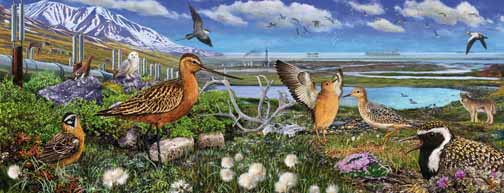
Recommendation
ABC seemed to have two goals for The American Bird Conservancy Guide to Bird Conservation. The first is for it to be an authoritative reference on bird conservation in the Americas. Mission accomplished. The second is to engage the birdwatching community in conservation. This is arguably the more important of the two. By producing such a beautiful, informative, and inspiring book, I think there’s a good chance of meeting this goal, too. Birder’s World said: “Hands down, this is the most important book of the year, one every birdwatcher should own.” I agree wholeheartedly.
More sample pages and a web presentation about this book are available at the American Bird Conservancy.
Disclosure: I get a small commission for purchases made through links in this post.
Disclosure: The item reviewed here was a complementary review copy provided by the publisher. But the opinion expressed here is my own, it has not been influenced in any way.

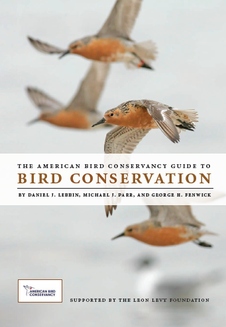


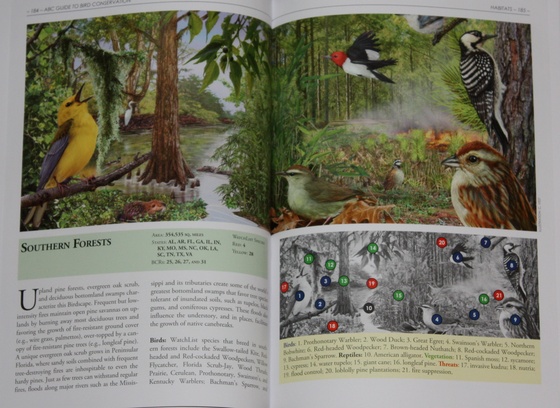
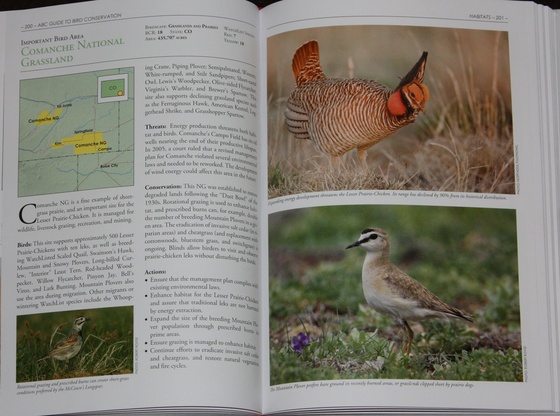

Comment